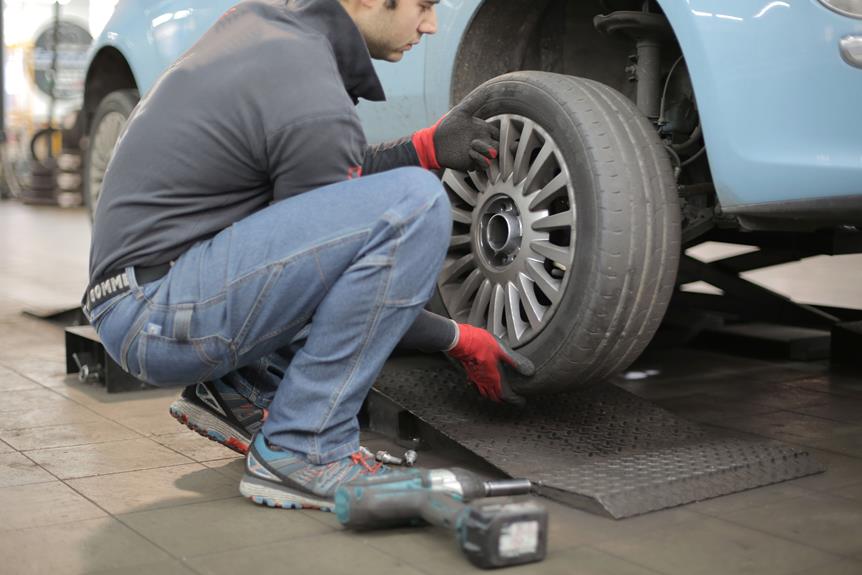Tire Maintenance Checklist: Keep Your Tires in Shape
Are your tires in shape?
Maintaining your tires is crucial for safety and optimal performance. In this article, we will guide you through a comprehensive tire maintenance checklist to keep your tires in top condition.
From checking tire pressure to inspecting tread depth, rotating tires regularly, aligning wheels, and more, we will provide you with expert tips and techniques to ensure your tires remain in perfect shape.
Stay tuned for valuable insights and practical advice.
Key Takeaways
- Regularly checking tire pressure and inflating them to the recommended level improves fuel efficiency, extends tire life, and enhances driving stability.
- Inspecting tread depth regularly using a tread depth gauge helps maintain tire safety and performance. Uneven wear patterns indicate alignment or suspension issues, and worn-out tires should be replaced.
- Regular wheel alignment and balancing are crucial for optimal tire performance, safe handling, and a smooth driving experience. Misaligned wheels and imbalanced tires can cause vibrations, uneven wear, and compromised handling.
- Examining tire wear patterns helps identify potential suspension and alignment issues. Regular tire rotations, proper tire inflation, and addressing any alignment problems promptly are essential for preventing uneven tread wear and maintaining tire lifespan.
Checking Tire Pressure
It is important to regularly check tire pressure to ensure optimal performance and safety on the road. Tire pressure maintenance plays a crucial role in maintaining the overall health of your tires. Proper inflation not only extends the life of your tires but also improves fuel efficiency and enhances driving stability.
Maintaining the correct tire pressure is vital for several reasons. Underinflated tires can cause increased rolling resistance, resulting in decreased fuel efficiency. They also wear out faster on the edges, leading to uneven tread wear and reduced traction. On the other hand, overinflated tires can lead to a harsher ride and reduced contact patch, negatively affecting braking and handling performance.
To maintain the proper tire pressure, it is recommended to check it at least once a month using a reliable tire pressure gauge. Ensure that the tires are cold before measuring, as heat generated during driving can increase pressure readings. Consult your vehicle's owner manual or the label on the driver's doorjamb to determine the correct tire pressure for your vehicle.
Regularly checking and maintaining proper tire pressure is a simple yet effective way to ensure the safety and longevity of your tires. By doing so, you can enjoy a smoother ride, improved fuel efficiency, and enhanced driving performance, all while ensuring the freedom to explore the open road with peace of mind.
Inspecting Tread Depth
Regularly inspecting tread depth is essential for maintaining tire safety and performance on the road. Tire tread wear is a common issue that can greatly affect the overall condition of your tires. To ensure your tires are in optimal shape, it is important to measure the tread depth regularly.
Here are some key points to consider when inspecting tire tread depth:
- Use a tread depth gauge: A tread depth gauge is a simple tool that allows you to accurately measure the depth of your tire treads. It is important to use this tool regularly to monitor the wear of your tires.
- Check for uneven wear: Uneven wear patterns on your tires can indicate alignment or suspension issues. By inspecting the tread depth, you can identify any uneven wear and address the underlying problem.
- Replace worn-out tires: When the tread depth reaches the minimum recommended level, it is time to replace your tires. Driving on worn-out tires can significantly compromise your safety on the road.
- Rotate your tires: Regularly rotating your tires can help evenly distribute the wear and extend the lifespan of your tires. This can be done every 6,000 to 8,000 miles or as recommended by your vehicle manufacturer.
Rotating Tires Regularly
Consistently rotating your tires is crucial to maintain their optimal condition and maximize their lifespan. Tire rotation involves moving the tires from one position to another on a regular basis. This process helps to ensure that the tires wear evenly and extend their tread life, resulting in improved performance and safety on the road.
One of the key benefits of tire rotation is that it promotes even wear across all four tires. As tires are driven, the front tires tend to wear differently from the rear tires due to factors such as weight distribution and steering. By rotating the tires, you can distribute the wear more evenly, which helps to prolong their lifespan and prevent premature wear.
Another advantage of regular tire rotation is that it can improve traction and handling. As tires wear down, their ability to grip the road decreases, especially in wet or icy conditions. By rotating the tires, you can ensure that each tire gets a chance to experience different driving conditions, allowing them to wear more evenly and maintain optimal traction.
The frequency of tire rotation depends on various factors such as the type of vehicle, tire type, and driving conditions. As a general guideline, it is recommended to rotate your tires every 5,000 to 7,500 miles, or as advised by your vehicle manufacturer. However, it is always best to consult your vehicle's owner manual or a professional mechanic for the recommended tire rotation frequency specific to your vehicle.
Aligning Wheels
Properly aligning wheels is essential in maintaining optimal tire performance and ensuring safe handling on the road. When wheels are misaligned, it can lead to uneven tire wear, reduced fuel efficiency, and compromised vehicle stability. To address this issue, it is important to understand the benefits of wheel alignment and the signs indicating the need for it.
Some benefits of wheel alignment include:
- Improved tire lifespan: Wheel alignment helps distribute the weight of the vehicle evenly across the tires, preventing excessive wear on specific areas. This extends the lifespan of the tires, saving you money in the long run.
- Enhanced fuel efficiency: Misaligned wheels can cause increased rolling resistance, which leads to decreased fuel efficiency. Proper alignment reduces this resistance, allowing the tires to roll more freely and improving fuel economy.
- Better vehicle handling: When wheels are aligned correctly, it ensures that the vehicle responds accurately to driver input. This results in improved steering control and overall handling, providing a safer driving experience.
- Reduced risk of accidents: Misaligned wheels can affect the vehicle's stability, especially during sudden maneuvers. Proper alignment minimizes the risk of accidents by ensuring that the tires maintain optimal contact with the road surface.
Regular wheel alignment checks are crucial for maintaining tire performance and ensuring safe driving conditions. By addressing wheel alignment issues promptly, you can enjoy the freedom of a smoother and safer ride.
Balancing Tires
To ensure optimal tire performance and a smooth driving experience, it is important to regularly balance your tires using a professional service and address any imbalances promptly.
Tire balancing is a crucial aspect of tire maintenance that involves equalizing the weight distribution of a tire and wheel assembly. Imbalances can occur due to variations in tire and wheel construction or external factors such as uneven road surfaces.
There are several tire balancing techniques employed by professional service providers. One common method is known as static balancing, where weights are added to the wheel to counterbalance any heavy spots. Another technique is dynamic balancing, which involves spinning the tire and wheel assembly on a machine to identify and correct any imbalances.
The importance of tire balance cannot be overstated. Imbalanced tires can cause uneven wear, leading to premature tire wear and reduced overall tire performance. They can also cause vibrations and instability, negatively impacting the vehicle's handling and safety.
By regularly balancing your tires, you can ensure a smoother, more comfortable driving experience and extend the lifespan of your tires.
Examining Tire Wear Patterns
Examining tire wear patterns is a crucial part of tire maintenance as it helps identify potential issues with the vehicle's suspension and alignment. Uneven tread wear, indicated by different levels of wear across the tire surface, can be a sign of misalignment or improper tire inflation.
Feathered edges, where the tread blocks on one side of the tire appear smoother than the other, may suggest a toe or camber alignment problem.
Cupping or scalloping, characterized by irregular wear patterns in the form of dips or scallops, can be caused by suspension issues or unbalanced tires.
Uneven Tread Wear
When addressing the issue of uneven tread wear, it is crucial to consider the driving habits that may contribute to this problem.
Uneven tread wear can occur due to various reasons, including:
- Improper tire inflation: Underinflated or overinflated tires can cause uneven wear patterns, putting strain on specific areas of the tire.
- Misalignment: Incorrect wheel alignment can lead to uneven tread wear, as it puts excessive pressure on certain parts of the tire.
- Lack of tire rotation: Not rotating tires regularly can result in uneven wear, as the front and rear tires experience different levels of wear depending on their position.
- Suspension issues: Worn-out or damaged suspension components can cause the tires to wear unevenly.
To prevent uneven tread wear, it is essential to practice proper tire maintenance, including regular tire rotations.
Tire rotation helps distribute wear evenly across all tires, extending their lifespan and ensuring optimal performance.
Feathered Edges
Inspecting the tire wear patterns, it is important to note the presence of feathered edges and address them promptly to prevent further damage.
Feathered tire edges refer to a wear pattern where the outer edges of the tread blocks are worn more than the center. This can be caused by several factors, such as improper wheel alignment, worn suspension components, or overinflation of tires.
To prevent feathered edges on tires, it is crucial to maintain proper wheel alignment by regularly checking and adjusting the camber, toe, and caster angles.
Additionally, ensuring that suspension components are in good condition and replacing them when necessary can also prevent feathered edges.
Lastly, maintaining proper tire pressure and avoiding overinflation is essential to prevent irregular tire wear.
Cupping or Scalloping
Three possible causes of cupping or scalloping on tires are:
- Improper Wheel Balance: When the wheels are not properly balanced, it can result in uneven weight distribution, causing the tire to bounce and create cupping patterns. Regular wheel balancing can help prevent this issue.
- Worn Suspension Components: Worn suspension components can cause the tire to bounce and create cupping or scalloping. It is essential to regularly inspect and replace worn shocks, struts, and other suspension parts.
- Insufficient Tire Rotation: Uneven tire wear due to lack of rotation can lead to cupping or scalloping. Regularly rotating the tires helps distribute the wear evenly, preventing such issues.
Cupping refers to the formation of irregular, scalloped depressions on the tire's tread surface. This can lead to a rough and noisy ride, decreased traction, and uneven tire wear. To prevent tire scalloping, it is important to address the underlying causes.
Cleaning and Protecting Tires
To maintain the longevity of your vehicle's tires, it is essential to regularly clean and protect them using high-quality tire cleaners and protectants. Not only does this enhance the appearance of your tires, but it also helps to prevent sidewall damage and prolong their lifespan. Tire shine products can be used to give your tires a glossy finish, making them look brand new. However, it is important to choose a tire shine product that is specifically designed for your type of tires, as using the wrong product can lead to damage.
In addition to using tire shine products, it is crucial to protect your tires from harmful elements such as UV rays and harsh chemicals. This can be achieved by applying a tire protectant that forms a protective barrier on the tire surface. This barrier helps to prevent cracking, fading, and discoloration caused by exposure to the sun and chemicals.
Regularly cleaning and protecting your tires not only keeps them looking great but also ensures their safety and performance. By following a proper tire maintenance routine, you can prevent sidewall damage, extend the life of your tires, and enjoy a smooth and comfortable ride. Remember to always read and follow the instructions provided by the manufacturer when using tire cleaners and protectants.
| Tire Shine Products | Preventing Sidewall Damage |
|---|---|
| Choose the right product for your tires | Avoid curbs and other obstacles |
| Apply the product evenly and in moderation | Regularly check tire pressure |
| Avoid overspray on the rims and brake components | Rotate tires regularly |
| Follow the manufacturer's instructions for application | Inspect tires for any signs of damage or wear |
Storing Tires Properly
Properly storing tires is crucial to maintaining their condition and prolonging their lifespan. When tires are not stored correctly, they can become damaged and unsafe for use. To help you keep your tires in the best possible shape, here are some tire storage tips and best practices:
- Clean the tires: Before storing your tires, make sure to clean them thoroughly. Remove any dirt, debris, or brake dust from the surface. This will prevent any corrosion or damage during storage.
- Inflate to the recommended pressure: It is important to inflate the tires to the recommended pressure before storing them. This will help maintain their shape and prevent flat spots from forming.
- Store in a cool, dry place: Find a cool, dry place to store your tires. Avoid areas with high humidity, extreme temperatures, or direct sunlight. These conditions can cause the rubber to deteriorate and age prematurely.
- Use tire racks or stands: To prevent damage to the tires, it is recommended to store them on racks or stands. This will help maintain their shape and prevent any distortion or flat spots.
By following these tire storage tips and best practices, you can ensure that your tires remain in good condition during storage and are ready for use when you need them.
Frequently Asked Questions
How Often Should I Check My Tire Pressure?
Regular tire inspections are crucial for maintaining optimal tire pressure. Checking tire pressure should be done at least once a month, as temperature fluctuations can affect tire pressure.
What Is the Recommended Tread Depth for Tires?
The recommended tread depth for tires is typically 2/32 of an inch. To measure this, you can use the penny test or a tread depth gauge. Proper tread depth ensures optimal traction and safety on the road.
How Do I Know When It's Time to Rotate My Tires?
Regular tire rotation is essential for maintaining tire performance and prolonging their lifespan. Signs of tire wear, such as uneven tread wear or vibration, indicate the need for rotation. Benefits include improved traction and even tire wear distribution.
What Are the Signs of Misaligned Wheels?
Misaligned wheels can cause uneven tire wear, reduced fuel efficiency, and poor handling. Signs of misalignment include uneven tire wear, pulling to one side, and a steering wheel that is off-center. Regular wheel alignment is important to ensure optimal tire performance and vehicle safety.
Can I Balance My Tires Myself or Do I Need to Take Them to a Professional?
DIY tire balancing may be possible for some individuals, but it is recommended to take tires to a professional for optimal results. Professionals have the necessary equipment and expertise to ensure proper balance, which leads to improved tire performance and longevity.
Conclusion
In conclusion, by following a tire maintenance checklist, you can ensure that your tires remain in optimal condition, allowing for a safe and smooth driving experience.
Properly checking tire pressure, inspecting tread depth, rotating tires regularly, aligning wheels, balancing tires, examining wear patterns, and cleaning and protecting tires are all essential steps to maintain the longevity and performance of your tires.
By incorporating these practices into your routine, you can symbolically pave the way for a more enjoyable and reliable journey on the road.







